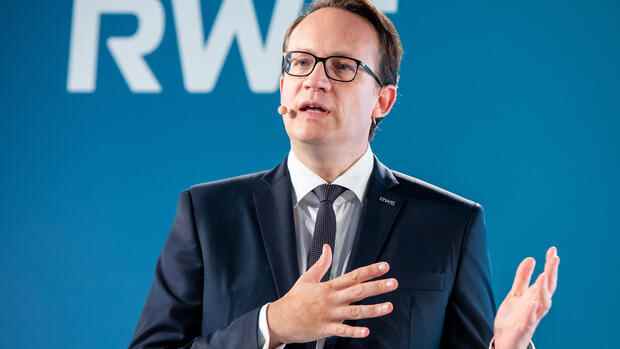RWE boss Markus Krebber exceeds the self-imposed goals.
(Photo: dpa)
eat Business is going well for the Essen-based energy company RWE. This is also reflected in the figures for the 2021 financial year, which the group presented on Tuesday. At EUR 2.19 billion, adjusted EBIT was significantly higher than in the previous year. The group thus exceeded its own forecast. In January, RWE had already surprised with record results and shortly thereafter announced a significant increase in the annual forecast.
RWE cited the “extraordinarily strong performance of energy trading” and higher earnings contributions from conventional power generation as the reason for the good result.
The prices for electricity, gas and other energy sources have risen massively in recent months. Due to the war in Ukraine, panic prevailed on the global energy market. The gas price rose to more than 300 euros per megawatt hour (MWh) on the spot market and was thus more than ten times as high as a year ago.
Coal prices have also skyrocketed: while a megawatt hour cost 67 euros a year ago, the price is currently 387 euros. In the electricity wholesale trade, one MWh now costs 500 euros – also ten times as much as a year ago.
Top jobs of the day
Find the best jobs now and
be notified by email.
The energy companies Uniper, VNG and Leag recently had to take out billions in KfW loans in order to have enough liquidity for security payments given the high prices. According to RWE, this has not been necessary so far.
While RWE’s Offshore Wind and Biomass/Water/Gas divisions increased, the adjusted Ebitda of the Onshore Wind/Solar division was significantly below the previous year’s result. The group attributes this primarily to the cold snap in the US state of Texas, during which numerous power plants failed. The unpredictable weather led to a total loss of 400 million euros. For the current fiscal year, the Group is assuming that business will develop normally.
Energy trading has grown considerably due to the current price rally. Here, Ebitda climbed from EUR 539 million in the previous year to EUR 769 million in 2021. The coal business is also growing significantly again: Ebitda in the coal/nuclear energy segment increases from EUR 559 million to EUR 889 million. For RWE, the profits from the sale of coal-fired power should flow even longer than expected.
Comeback for coal?
In order to become less dependent on Russia, Federal Economics Minister Robert Habeck is examining the continued operation of old coal-fired power plants. In view of the Russian attack on Ukraine, it must be ensured that coal-fired power plants are available as a back-up, according to a ministry paper. It refers to lignite-fired power plants from the so-called security reserve.
“It is the need of the hour for politicians to consider the full range of measures to reduce our dependence on Russian commodity imports. One possibility can be to use coal-fired power plants that are in reserve or on standby again,” an RWE spokesman said a few days ago. It can also be checked whether systems that have already been shut down could be brought back to the grid.
Another way to help the system is to delay shutdowns that are due this year. “We are examining this for our lignite-fired power plants so that we are able to act if the federal government deems such measures necessary,” the RWE spokesman continued.
>> Read here: Fears of a gas supply stop are growing in the energy sector
But even without additional coal energy, RWE expects a decent result for 2022 at group level, between 3.6 and four billion euros. So far, the company had promised a range of 3.3 to 3.6 billion. For 2022, the utility wants to keep the dividend stable.
RWE is in the midst of a transition from a former coal giant to one of the largest providers of green electricity in Europe. With the help of an investment offensive worth billions, RWE wants to expand its green capacities from the current 25 to 50 gigawatts by 2030.
In 2021, a total of around 3.7 billion euros gross went into the expansion of renewables. That is twelve percent more than in the previous year.
More: Crisis on the energy market: the federal government had to support the lignite group Leag with a loan worth billions

